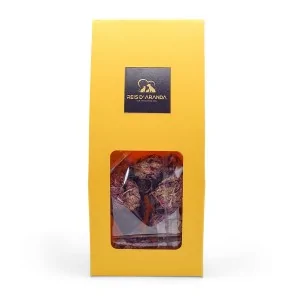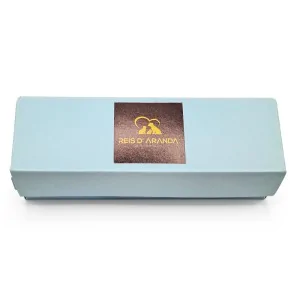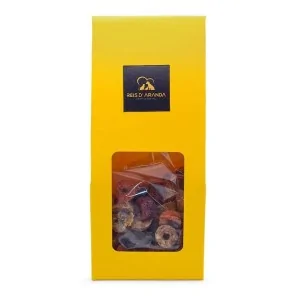Its name says it all: the Vienna blue rabbit comes from Austria. Not only is it beautiful with its shiny blue-grey...
THE NETHERLAND DWARF RABBIT
THE NETHERLAND DWARF RABBIT
The Netherland Dwarf is the smallest rabbit breed in existence, the most complex to breed and the most popular with breeders around the world.
This breed of rabbit (belonging to the dwarf rabbits) is characterised by its small, round and compact body, tiny ears, large, lively eyes and flat profile.
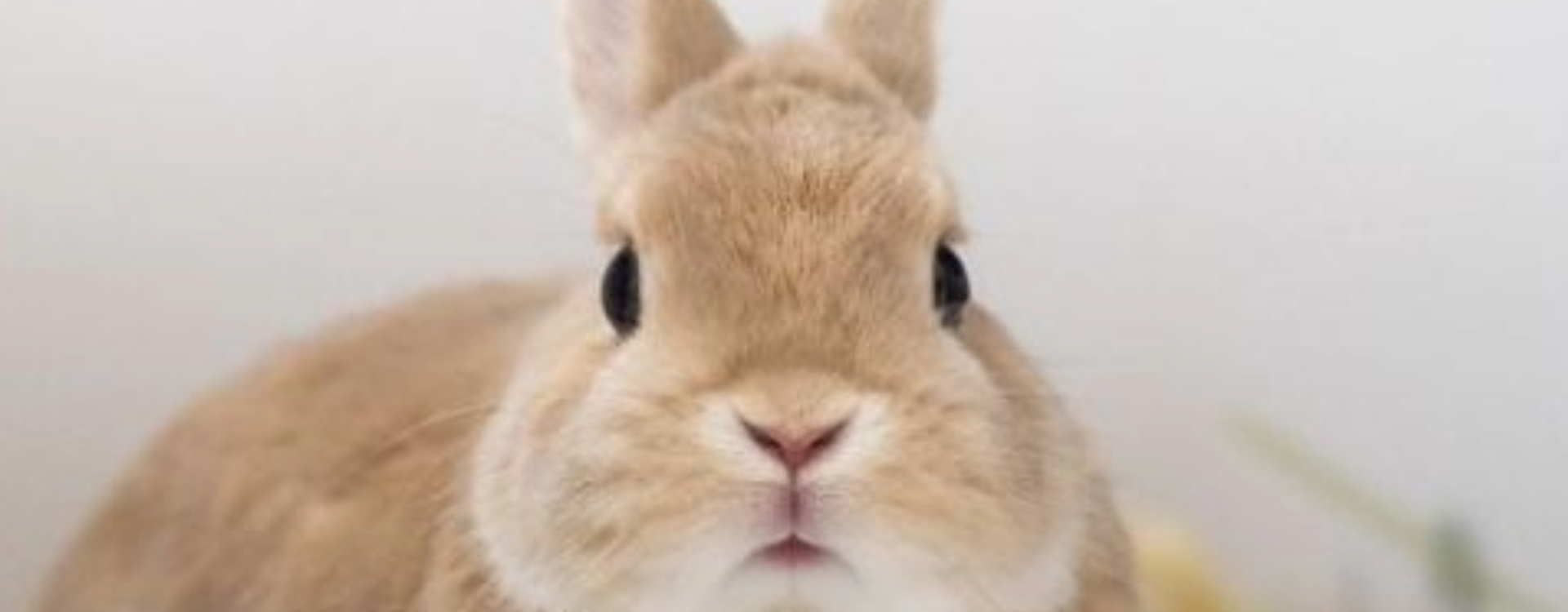
THE ORIGIN OF THE NETHERLAND DWARF RABBIT
The origin of the Netherland Dwarf goes back to the early 1880's in England, when mutations arose in some litters of Dutch rabbits, e.g. white rabbits with red eyes [REW], with a small body similar to the Dutch and a soft coat. These were called "Polish". These mutations were bred with great care to the offspring obtained and, as a result, more of these white rabbits with red eyes [REW] appeared. This new breed was first exhibited in 1884 in Hull (England) and then exported to Germany.
Their arrival in Germany brought great excitement and it was at this time that a standard similar to that of today's Netherland Dwarf was created. The white rabbits were crossed with small wild rabbits which improved their type, resulting in agouti-coloured rabbits. In the next generation black rabbits were obtained and finally the white rabbits reappeared. Mr. Otto Lippolt got the credit for perfecting the breed, now known as "Hemelin". These were very popular in Germany and were soon exported to the Netherlands.
Until the end of the 1930's, the accepted colours were white with blue eyes [BEW] and white with red eyes [REW]. At that time the breeder bred dogs of different colours. After years of careful breeding, the Dwarf Dutch we have today was obtained and given an official standard in 1940.
After the Second World War, the Dwarf Dutch returned to England. At that time, some English fancy Rex rabbit breeders visited the Netherlands to help the Dutch breeders, whose rabbit hutches had almost been emptied or ceased to exist due to the German occupation. In 1947, the English, seeing a Netherland Dwarf show in Amsterdam, fell in love with the breed. Their desire to acquire the breed and take it with them back to their country proved impossible, as at that time there were only seventeen surviving Netherland Dwarfs left from the occupation. Finally, in 1949, Joyce Naylor and some other fancy rabbit breeders were able to obtain nine of these precious jewels. On 13th October 1949 the National Netherland Dwarf Rabbit Club [NNDRC] was founded. The popularity of the breed grew rapidly and, in 1950, the British Rabbit Council gave them official recognition. A total of eighteen Netherland Dwarfs were exhibited at the first dwarf rabbit show in New Malden (Surrey).
THE STANDARD OF THE NETHERLAND DWARF RABBIT
The standard used in Spain is that of the United Kingdom, and explains very clearly what an ideal Netherland Dwarf should look like; no animal is 100% perfect as it should be, but it is the job of ethical breeders to maintain typicality and try to get as close as possible.
Each part of the body is scored according to a table; below we can read about it and check the points allocated, which are in brackets:
BODY: [30]
-The body of the Dwarf Dutchman is short and compact, with a well developed and full chest, the shoulders are long and strong, while the forelegs are short and straight.
WEIGHT:
-The weight in adulthood should be as close as possible to 900gr.
EARS: [15]
-Set on high, erect, vigorous and robust, well covered with hair and slightly rounded at the tip. The ideal size is 5 centimetres.
EYES: [5]
-Round, large, bright and well coloured. The colour of the eyes should be in accordance with the coat of the dog.
HAIR: [10]
- Short in length, soft to the touch and fully capable of returning to its original position when handled.
HEAD: [15]
-Round, with a long skull.
COLOUR: [15]
-All recognised "normal" colours are acceptable. The vienna gene and its subtypes are not accepted in show.
GENERAL CONDITION: [10]
-Teeth, ears and eyes should be in perfect hygienic and health condition and show minimal yellowish markings on limbs.
FAULTS:
-Narrow shoulders, ears not erect, folded or above ideal size, narrow face, white hairs and nails on coloured animals (e.g. black, blue, red, otter and shaded animals) "ticking" on shaded animals and black hairs on blue coloured animals. Hair not in proper condition.
DISQUALIFICATIONS:
-Animals of thin build and slight structure, crooked legs, coat without correct colouring, strabismus and/or eyes with spots, white spots in armpits, unpigmented nose, specimen less than 5 months old and weighing 0.900 kg (if in the judge's opinion the specimen was too developed for its age, it should be disqualified regardless of its weight) Overdeveloped or split teeth. Eyes purulent. If the dog is not in good health it will not be judged. Adult specimens weighing 1.134 kg or more.
**
THE NETHERLAND DWARF RABBIT AND THE TOY RABBIT
Many people confuse the two terms, mainly because due to their lack of knowledge of the rabbit world they easily swallow the lies told by the macro-farms (pet factories).
A Dwarf Dutch is a breed recognised by all the breeders' clubs and large associations in the world, with an origin, morphology and personality fixed by selection made over decades.
The "toy", "super toy" or "mini/micro toy" rabbit, as we have explained in another article of our blog, is a mongrel animal, without breed, whose cards (wrongly called "pedigrees") and definitions are not accepted by any national or international club.
If someone is looking for or their lifestyle requires a very small sized rabbit, they should always opt for the Dwarf Dutch (900gr-1,100kg) from an ethical breeder who is federated in a national or international club, the common shops do not have this type of rabbit and, if we end up buying a "toy rabbit" we will only have a surprise box that can end up in a 1kg rabbit or an 8kg rabbit.
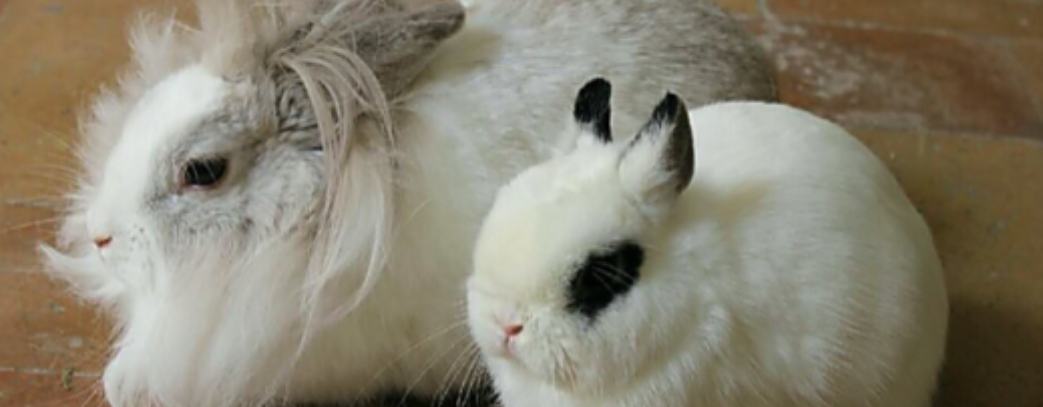
Toy rabbit (left) with an adult Netherland Dwarf rabbit (right) [PHOTO: Milkonejos - Spain].
THE PERSONALITY OF THE NETHERLAND DWARF RABBIT
The Netherland Dwarf rabbit is an energetic, very active and curious rabbit, it is quite expressive and its eyes always reflect a continuous state of "surprise".
It can be a rather nervous and sensitive animal, so it is only recommended for adults or families with older children (over 10 years old), as this same energetic personality can result in falls or scares that can lead to accidents.
THE HEALTH OF THE NETHERLAND DWARF
The Netherland Dwarf is not a sickly animal despite its small size, the major ailments it can suffer from are genetic in nature linked to the dwarfism gene (which we can read about in its corresponding article).
Many people believe that just because it is flat, the Netherland Dwarf is more likely to suffer from malocclusion or chronic rhinitis; this is a mistake, as both diseases/malformations are perfectly preventable.
Malocclusion has a strong genetic component, and no ethical breeder breeds rabbits with malocclusion as this can seriously damage their reputation, professionalism and credibility. The world of rabbit breeding is a small one and everything becomes known.
If it is detected that a healthy rabbit has given offspring with malocclusion (before weaning) this reproducer is withdrawn and put up for adoption, already castrated or with a commitment to castrate.
In the case of rhinitis, most of the time it is caused by problems linked to the environment, such as allergies or an excess of dust and ammonia (accumulation of urine) in an environment with little or no ventilation.
CONCLUSION
The Netherland Dwarf is a fantastic breed of dwarf rabbits, with a fascinating history and a large number of fans around the world, but is also the most complex and unprofitable breed to breed.
Active, energetic, friendly... Their round cheeks and tiny ears dazzle those who know them and, as companions, they will bring a smile to your face.
HOWEVER YOUR PET COMES INTO YOUR LIFE: ADOPTED, BOUGHT OR FOUND; REMEMBER THAT YOU ARE THE ONLY THING THEY HAVE IN LIFE.
BE RESPONSIBLE, GIVE HIM LOVE, TAKE CARE OF HIS HEALTH AND DON'T ABANDON HIM.
IF FOR WHATEVER REASON YOU HAVE TO SEPARATE FROM HIM, LOOK FOR HELP, LOOK FOR A FAMILY THAT CAN GIVE HIM ALL THE LOVE YOU HAVE GIVEN HIM, OR EVEN MORE.
Leave a comment
Log in to post comments
Comments
Super cute
By: Candace On 05/16/2024The world's most beautiful rabbit breed
Busco uno d stos
By: Juan Carlos On 05/16/2024Busco uno d stos en madrid
Buena información
By: Ana González On 05/16/2024Buena información para los que buscamos un conejito pequeño, yo vivo en un piso muy pequeño y no quiero tenerlo en una jaula
A mí me engañaron
By: Mari Carmen On 05/16/2024Le compré a mi hijo un super toy con pedigri que me dijeron que era como estos y mentira, se puso super orejón, pesaba como 3kg y era más malo que un demonio...
Muy lindos
By: Ivana Alexandra On 05/16/2024Una raza muy linda, en mi pais no existen pero me encantaría tener uno, me hubiera gustado que el artículo tuviera más fotos pero me ha parecido muy interesante.
Super bonitos
By: Raquel On 05/05/2024Que pasada, tan chiquitillos y redondos. Me encanta


